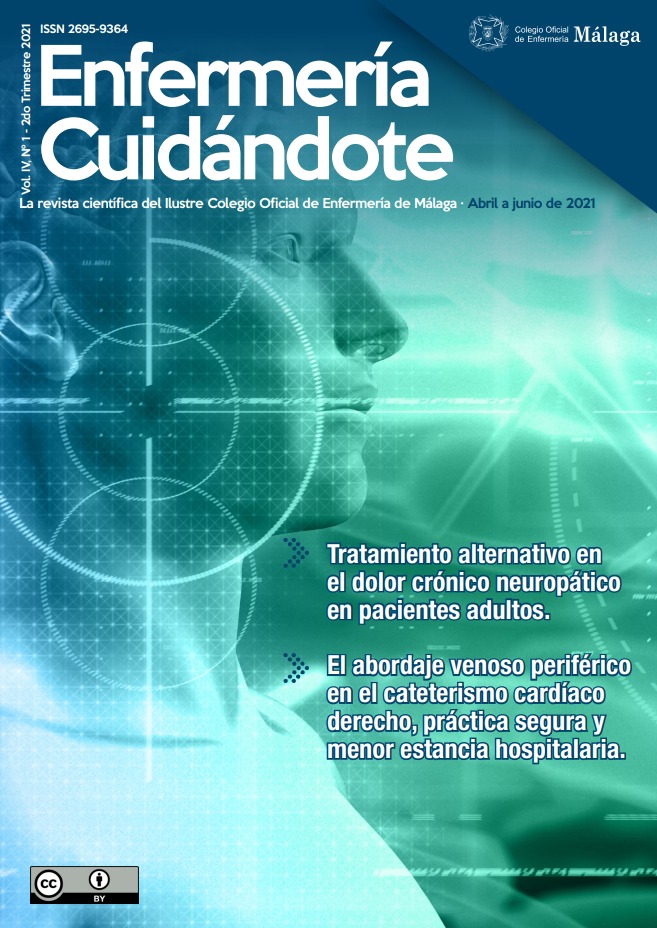The Peripheral Venous Approach in Right Heart Catheterization, Safe Practice and Shorter Hospital Stay
DOI:
https://doi.org/10.51326/ec.4.1.4130324Keywords:
Cardiovascular, Cardiac catheterization, Cardiac care, Nurses, Venous Access.Abstract
Introduction: Right catheterism is necessary for the diagnosis and evaluation of pulmonary hypertension and pulmonary and mitral valve disease. The venous approach for this procedure can be performed through a central venous line or through the trans-ulnar veins. Peripheral access (anterocubitals) could be a good alternative in order to reduce potential complications, providing benefits to the patient and to the operators of the hemodynamic room due to its easy canalization, due to there duction of intervention times and radiation dose.
Objectives: To observe the benefits of performing the right catheterism by peripheral approach with respect to the femoral veins and to enhance the role of nursing in the peripheral approach necessary for catheterism. As well as highlighting the importance of nursing staff in canalization it and subsequent management.
Methodology: An retrospective observational study was carried out with a sample of 22 patients who were made right catheterism in the hemodynamic operating room of the Costa del Sol hospital in the period between January 2019 to February 2020 whose venous approach was performed by peripherally and femorally independently.
Results: It was observed that the procedures carried out by peripheral venous Access reduced hospitalization times, scopia times and procedure duration, and consequently, reduced radiation dose.
Conclusion: The right catheterism performed by peripheral venous Access present benefits for the patient and for the development of the procedure, where nursing has an important role due to its habilities to canalize peripheral venous access.
Downloads
References
Buendía, S., Herráez, J. y Duel, M. (2007) “Abordaje cubital/radial para el cateterismo derecho e izquierdo”, Enfermería en Cardiología, 41 (2), pp. 33-34.
Casado Dones, M. J. y Casado Dones, M. R. (2008) “Papel de enfermería en el manejo del catéter de Swan-Ganz”, Enfermeria Intensiva, 19 (3), pp. 141-149. doi.org/10.1016/S1130-2399(08)72756-1
Conde Camacho, R., y Cabrales Arévalo, J. (2017) “El cateterismo derecho como herramienta en el diagnóstico de la hipertensión pulmonar. Revista colombiana de Cardiología, 24, pp. 28-33. doi:10.1016/j.rccar.2017.08.005
Consejo de Seguridad Nuclear. (s. f.). Protección Radiológica. Disponible en: https://www.csn.es/proteccion-radiologica [Consultado: 05-06-2020].
Duwadi, S., Zhao, Q. y Budal, B. S. (2019) “Peripherally inserted central catheters in critically ill patients – complications and its prevention: A review”, International Journal of Nursing Sciences, 6 (1), pp. 99-105. doi.org/10.1016/j.ijnss.2018.12.007
España (2009) “Real Decreto 1085/2009, de 3 de Julio, por el que se aprueba el Reglamento sobre Instalación y utilización de aparatos de rayos X con fines de diagnóstico médico”, Boletín Oficial del Estado, 18 de julio de 2009, núm. 173, pp. 60188-60211.
Guzmán Pérez, M., Fernández Sánchez, R. y Barón Ibáñez, O. (2012) “Apuesta por el acceso anterocubital en el cateterismo derecho”, Enfermería en Cardiología, 57 (3), pp. 45-50.
Konstantinou, E. A., Karampinis, D. F., Mitsos, A. P., Konstantinou, M. I., Mariolis-Sapsakos, T., Kapritsou, M., Stafylarakis, E., Katsoulas, T. y Elefsiniotis, I. (2013) “Central Vascular Catheters versus Peripherally Inserted Central Catheters in Nurse Anesthesia. A Perspective within the Greek Health System”, The Journal of Vascular Access, 14(4), pp. 373-378. doi.org/10.5301/jva.5000160
Kusa, J., Bérmudez-Cañete Fernández, R. y Matías Mejía, S. (2004) “Acceso venoso percutáneo braquial: Su utilidad en el cateterismo diagnóstico e intervencionista en cardiopatías complejas”, Archivos de Cardiología de México, 74 (4), pp. 271-275.
Muñoz, J. I. y Roselló, P. M. (2005) “Canalización de vías venosas centrales”, An Pediatr Contin, 3 (2), pp. 109-113.
Navarra, M., Bote, M. y Martínez, M. A. (1999) “La implantación del catéter de Swan-Ganz por vía antecubital ¿Está demostrada la eficacia en enfermería?” Enfermería en cardiología, 17, pp. 30-33.
Downloads
Published
Versions
- 2021-04-16 (3)
- 2022-02-15 (2)
- 2021-04-16 (1)




















